Housing of monkeys at KM-F
All monkeys at Karolinska Institutet are housed at KM-F (Astrid Fagræus Laboratory), which was built specifically to offer them the best possible environment. KM-F is the first in Sweden to become accredited by AAALAC International Organization for its high quality of animal welfare. The lab also meets very high standards in terms of infection control and working environment.
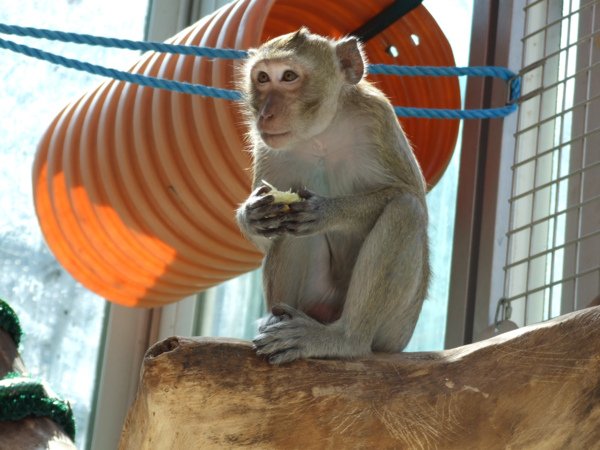
Large and generously equipped areas
All of the monkeys at KM-F (Astrid Fagræu's laboratory) have a good and stimulating environment in flexible cage systems and aviaries. The cages are designed to give the monkeys the greatest possible scope to move around, jump, climb and adopt any conceivable body position without hindrance. Ropes, swings, shelves, climbing frames, hay-filled nests and so on are used to increase the useable area and make the entire volume of the cage available to them.
It is important to provide viewpoints and comfortable perches where they can keep an eye on their surroundings. The platforms are wide enough for two or more monkeys to sit comfortably and groom one another.
The cages contain a mixture of fixture and temporary fittings that can be changed at regular intervals – we aim to have roughly two-thirds permanent and one-third temporary.
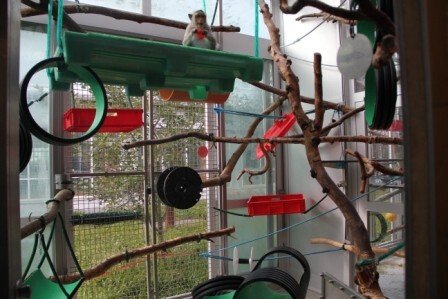
The apparatus have to to be at different heights so that eye contact between monkeys on different perches can be avoided, as this can be seen as a threat by many monkeys. The cages measure at least four cubic metres (for two monkeys), offer access to daylight and are designed to allow the monkeys to express their normal behaviour.
Different materials
When it comes to the materials used to make the furnishing, the monkeys do not have any particular favourite. We use fittings made from different materials to provide variation for the monkeys, such as wood, PVC and laminated board (all taking due account of the safety of both animals and staff).
The monkeys' preferences, hygiene and the durability and availability of materials decide which ones are chosen. Having objects that differ in colour, structure, texture and strength is beneficial for the animals.
Fittings checked
We have introduced "certification" of all cages once they have been fitted out suitably for the monkeys. This includes making the entire volume of the cage available to the animals through a mixture of stable structures such as branches and PVC pipes, and plastic trays hung from lightweight plastic chains or fire hoses to make them more mobile. There must also be mirrors and visual barriers in all of the cages, as well as access to a bathtub once a week.
The animals love to fiddle around with the apparatus, jumping onto branches to knock them down and chewing things to pieces – whereupon they are repaired or replaced. Having objects of different shapes, sizes, colours and strengths enriches the monkeys' environment.
Visual barriers
Although the monkeys are kept in groups who get on well, they still need an opportunity to get away from their cage mates. A flexible system of visual barriers enables low-ranking individuals to withdraw from dominant individuals' field of vision.
Studies have shown that these barriers lead to increased contact and decreased aggression, even though at first glance the monkeys do not actually seem to use them. This is particularly important for animals kept in groups of more than two.
Monkeys need a sense of control
It is important for the monkeys' well-being that they feel a degree of control. This makes them bolder, more curious about new things and better at coping with stress.
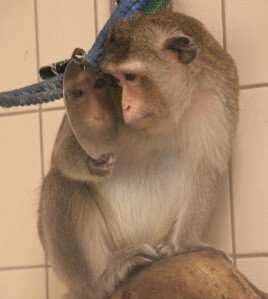
Some activities are initiated and controlled by the monkeys themselves (such as grooming, play and foraging), while human activities are outside their control (cleaning, feeding and taking part in experiments). Where the monkeys are not in control, it is important to give them a clear signal of what is about to happen so that they learn to anticipate and get used to such events.
Training the animals is important as it enables them to feel in control and therefore reduces their stress response during interactions. Another important aspect of control is having places to hide and places with a good view. Mirrors are used to expand the visual field and avoid direct eye contact, which may be intimidating.
Enrichment
At KM-F we have developed ways of enriching the environment to stimulate behaviour typical of crab-eating and rhesus macaques, with the focus on foraging and exploring. We come up with some of these techniques ourselves, but have found much useful information in the extensive literature on the welfare of captive primates.
The animals' intellectual and physical capabilities are stimulated by giving them an opportunity to investigate and handle different objects. Enrichment takes two forms: food enrichment and toys that do not offer an edible reward.
Food enrichment
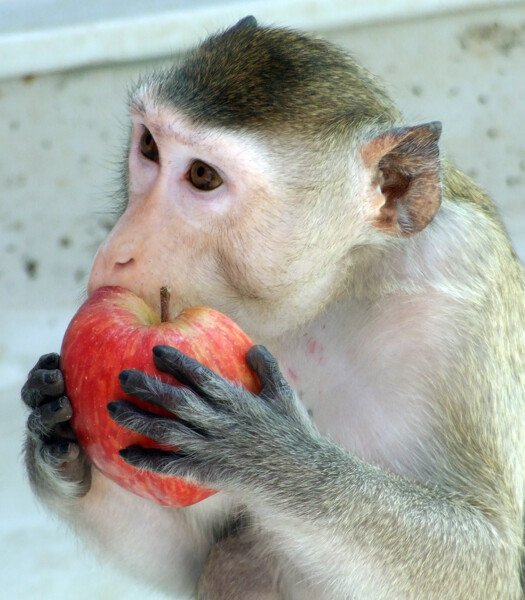
At least half of the monkeys' diet is in the form of nutritionally balanced pellets, while the remainder consists of fresh vegetables and fruit. The monkeys are given pellets in the morning and afternoon. During the afternoon they also get to eat vegetables. During interaction training, and as feeding enrichment, grain, nuts and raisins are provided. We aim for them to spend the same amount of time foraging as they would in the wild, which means they need to "work" for their food.
We sprinkle seed and small pellets into the straw bedding, and use special containers where the monkeys need to spend a long time getting the food out. This is done in ways that allow all of the monkeys in a cage to benefit at the same time.
A variety of substrates for foraging
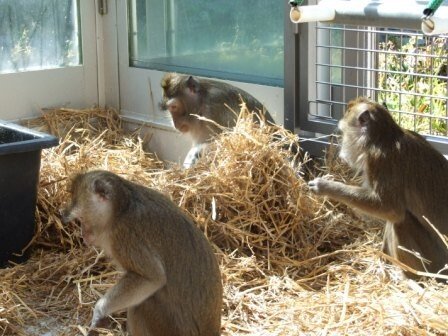
Aspen wood shavings, straw and wood wool are all used on the cage floors and provide a place to hide pellets, seeds and other treats. Food enrichment might mean placing food in plastic crates or containers with small holes that allow access to the food.
Scientific studies have shown that aggressive behaviour is reduced up to 20-fold and inactivity also decreases if food enrichment techniques are used. Straw is a great material for hiding treats such as raisins, nuts and seeds.
Challenging food puzzles
At KM-F we also encourage the monkeys to use their intelligence, for example by setting them tasks that involve various forms of problem-solving. One way is to put treats inside a puzzle which needs to be solved for the animals to get to them. We do not serve their daily pellet ration in open bowls - instead they must pick the pellets out through a grille across the opening into the container. This enables the monkeys to practise their dexterity, and studies have shown that it increases the time taken to eat the pellets as much as 50-fold.

The monkeys therefore spend more time seeking, handling and consuming their food – just as in nature. An even greater intellectual challenge is presented by the peanut puzzle, which requires lengthy practice before the monkey cracks how to obtain the reward of tasty treats.
Ice cubes, frozen fruit or juice have proved popular. We build platforms for the monkeys covered in artificial grass onto which we pour things like crushed pellets and bird seed.
Toys
Toys suitable for monkeys must not cause them harm when they break. They must also stimulate all of their senses, including smell, sight, touch and taste. Toys must therefore be chosen very carefully. We use things like phone books, branches, pine cones and bits of wood that can be torn or chewed to pieces and constantly change shape.
Mirrors, tennis balls and empty plastic bottles are also used. Despite being carefully washed, the bottles always retain a trace of the aroma of their former contents, making them very interesting. All environmental enrichment follows a carefully tried-and-tested schedule. This ensures that all animals enjoy the same levels of care even though they have different keepers.
Bathtubs
Both crab-eating and rhesus macaques like to swim in the wild and have been observed playing in water. Small plastic tubs of water have proved to be an excellent form of enrichment. Some monkeys bathe carefully in the warm water, while some climb up onto branches and plunge in, rinse their fruit in them or fill them with straw - and others just tip them up. All monkeys at the AFL are given water to bathe in at least once a week.
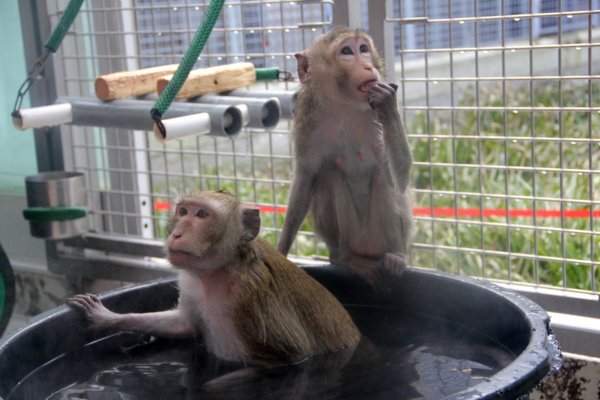
The social environment
Together with others
For monkeys to thrive in captivity, their social needs must be met. Living together with other monkeys is generally the single most important factor affecting their wellbeing. Being in a social environment with others gives them an opportunity to perform many behaviours specific to their species, such as grooming and play.
Keeping monkeys in groups is not without its problems. The larger the group, the greater the risk of aggression, injury and spread of disease. We must therefore constantly monitor how a group is functioning to see if anything is amiss.
Dominance hierarchies
The housing environment is well equipped according to certain environmental enrichment standards to keep the monkeys active.
We can never completely prevent fighting within the groups. Both species of macaque live in dominance hierarchies both in the wild and in confinement, and although strict ranks generally reduce the risk of aggression, relationships between individuals are not constant but are continuously tested. Ranking changes can also occur in an otherwise stable group. The monkeys' relationships with one another are documented.
Small groups
No monkeys at KM-F are kept in solitary confinement. Most are housed in small groups of two or three. We try to avoid groups of more than ten, because the larger the group, the more complex the social interaction within it. It can be quite hard for low-ranking individuals to keep an eye on all of the dominant individuals. There is also better contact between keeper and animal if the group is smaller, because low-ranking individuals are then more likely to have the courage to have close dealings with the keeper.
We therefore pay particular attention to relationships in larger groups – the stability of the group depends largely on how the dominant individual exercises that dominance, and the size of the group needs to be adapted accordingly. Large groups also mean a greater need for carefully designed cage interiors, with visual barriers and the best possible use of the available space.
Training
Scientifically based
Our training programme has been developed on the basis of extensive study of the scientific literature and participation in various theoretical and practical courses. Techniques such as positive reinforcement have been discussed with a variety of professional trainers with experience of training everything from dolphins and gulls to pigs and primates.
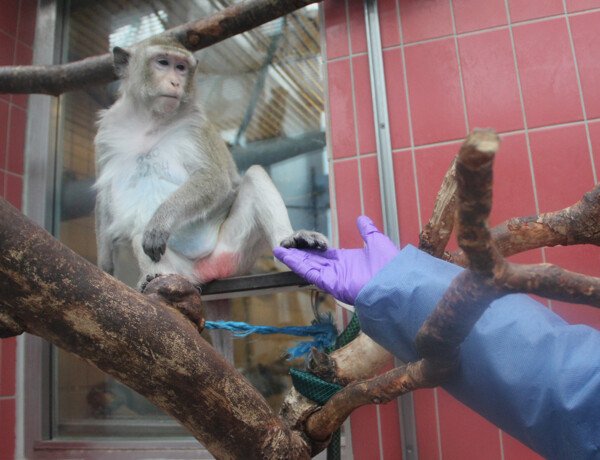
Drawing on this information, we have developed an education system for our animal technicians where they learn techniques for training at the KM-F.
Positive reinforcement
We aim to harness the monkeys' intelligence and learning capacity with positive training so that they cooperate when handled. The idea is to reduce stress and train the animals to cooperate with daily routines, such as moving between different parts of the cage to allow cleaning and being close to the animal handler. Positive reinforcement training (PRT) involves rewarding the monkeys with treats when they perform a desired behaviour.
This increases the chances of them performing the same behaviour again. The method depends on a good relationship between keeper/trainer and monkey. Clicker training is a technique which teaches the monkeys to associate the sound of a clicker with a particular desired behaviour, and this in turn is associated with a reward in the form of a treat such as raisins or peanuts.
Training in the home environment
Also important is that training takes place in familiar surroundings - the monkeys' home environment. Moving them out of their cages to collect samples has documented effects on levels of stress hormones, regardless of how the samples are taken. It has also been documented that the interaction between a monkey and familiar keepers can have positive effects. For example, there is a reduced risk of aggressive-defensive attacks on the keeper. In the longer term, training means that fewer people need to be involved in collecting samples, and the process takes less time.
Training animals to cooperate with sample collection has been shown to lower levels of the stress hormone cortisol in the blood relative to more stressful techniques. Cooperation training not only means less stress for the animal but also improves the quality of the research results, as many of the body's functions can be affected by stress. It is therefore a key priority at the AFL to train our monkeys to cooperate with routine sample collection and daily handling.
Breeding and transport
Imported monkeys
We do not breed our own monkeys but import the animals we use in experiments from breeding facilities in other countries, mostly from Asia. No monkeys at KM-F have been caught in the wild. The monkeys normally spend at least a month in quarantine in the Netherlands before traveling on to KM-F.
Transport
As there are no breeding programmes in Sweden, the monkeys have to be transported here from abroad. This can entail very long journeys by both air and road. The journey from the breeding facility can often be tough on the monkeys, but we aim to make it easier for them by insisting that they are transported together in compatible pairs where possible. Once the monkeys reach KM-F, they are normally alert and active, and have been eating and drinking. They then spend at least 6-8 weeks acclimatization to their new environment before any tests begin.
In the wild
The macaques' natural environment
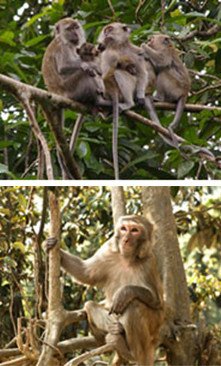
We keep two different species of monkey at the AFL: the crab-eating macaque (Macaca fascicularis, also known as the long-tailed macaque) and the rhesus macaque (Macaca mulatta, also known as the rhesus monkey). Both belong to the macaque family, which consists of 15 different species.
The crab-eating macaque lives in Southeast Asia and on Mauritius in a variety of environments ranging from mangrove swamps to subtropical forests at altitudes up to 2,000 metres. The species is not exclusively a tree-dweller, but does spend the night and seek protection in the trees. Rhesus macaques are found from Afghanistan in the west through India and southern China to Southeast Asia, in both lowland areas and highland forests. They are primarily ground-dwellers but are happy to climb into the surrounding trees.
Home range and daily path
Macaques are not particularly territorial and can have home ranges that overlap those of other troops. Both species are very flexible in the size of the area they roam, which probably depends on the nature of the home range, the number of monkeys in the troop and the distribution of food. They travel several hundred metres a day within their home range, which may extend to more than 100 square kilometres.
Social structure
In the wild, crab-eating macaques live in social groups averaging 12-25 animals, and troops of up to 100 have been seen. Rhesus macaques live in social groups averaging around 30 animals, although there have been reports of troops as small as two and as big as 250. Both species consist of clans of related females who form the backbone of the group. There will also be a number of unrelated adult males. Males leave the troop on reaching sexual maturity (aged 3-4 for crab-eating macaques and 3.5-5.5 for rhesus macaques), while the females remain with the group.
Reproduction
Males mature later than females, but both sexes grow and develop socially for several more years. Physically, socially and reproductively, males are fully grown at the age of 5.5-6.5. Females have their first young aged between 3.7 and 5. Pregnancy lasts just over five months, the young remain with their mother for about 12-14 months, and the interval between births is 12-24 months.
Food and foraging
Both species eat mainly fruit, but leaves sometimes form part of their diet. They also consume insects, snails, mussels, fish and small vertebrates. Studies of wild macaque troops have shown that the breakdown of their day differs somewhat depending on environment, season and whether they have close contact with humans. In general, though, they spend 15-35% of their time foraging, 30-40% resting and 20-45% moving around in different groups.
Application at Astrid Fagræus Laboratory
Macaques seek out elevated perches even in a caged environment. We are therefore careful to equip the cages in such a way that they can sit up high and make full use of the available space.
A study carried out at the AFL found that the monkeys spent around 35% of their time foraging, 45% resting and social grooming, and 20% moving around and performing other activities, which closely mirrors what happens in the wild.
Both crab-eating and rhesus macaques like to swim – to find food, to have fun, to regulate their temperature and to escape predators. Read more about this under Enrichment, which describes how they are given bathtubs to bathe in and how they use this opportunity.
